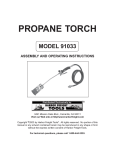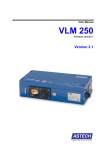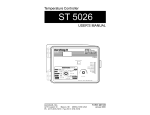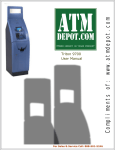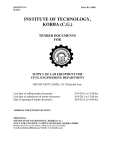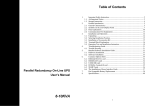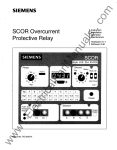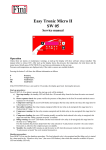Download USER`S MANUAL
Transcript
Potentiometer Feedback Inlet Controller PF-6 USER'S MANUAL TABLE OF CONTENTS PRECAUTIONS ........................................................ 3 FEATURES .............................................................. 4 LOCATION OF THE CONTROLS ................................. 5 CONTROLLER STATUS LEDS ................................................... 5 INTERNAL SWITCHES ............................................................. 6 INSTALLATION PROCEDURE ..................................... 7 PF-6 OPERATION ....................................................15 OVER-OPENING STAGE (OPTIONAL) ....................................... 18 BEFORE CALIBRATING THE REFERENCE POINTS ....................... 20 CALIBRATION PROCEDURE ................................................... 21 CONTROLLER FUNCTIONS ......................................23 ACTUAL OPENING ............................................................... 23 IDENTIFICATION NUMBER ..................................................... 24 OVER-OPENING SETTING ...................................................... 25 PROGRAMMING .................................................................. 26 ALARMS - READOUT ............................................................ 27 ALARMS - HIGH .................................................................. 28 ALARMS - LOW ................................................................... 29 ROOM TEMPERATURE .......................................................... 30 TROUBLESHOOTING GUIDE .....................................31 TECHNICAL SPECIFICATIONS ...................................32 FACTORY SETTINGS ...............................................33 FOR CUSTOMER USE Enter below the serial number located on the side of the controller and retain this information for future reference. Model number Serial number 2 PF-6.rev.07 PF-6 PRECAUTIONS Fuses at the input and outputs of the controller adequately protect its circuitry in the case of an overload or overvoltage. However, we recommend that you install an additional protection device on the controller's supply circuit to prolong the life of the controller. The room temperature of the room in which the controller is located MUST ALWAYS REMAIN BETWEEN 32° AND 104°F (0° AND 40°C). To avoid exposing the controller to harmful gases or excessive humidity, it is preferable to install it in a corridor. DO NOT SPRAY WATER ON THE CONTROLLER PF-6.rev.07 3 FEATURES The PF-6 is an electronic device used for air inlet control in livestock buildings. In combination with an environment controller, the PF-6 coordinates the movement of the air inlets with the operation of the fans using a potentiometer located on the panel drive. Additional units can be connected to the PF-6 for an independent control of additional air inlets. The main features of the PF-6 are as follows: DIGITAL DISPLAY A digital display shows the operation parameters and alarm messages. PILOT LIGHTS Pilot lights indicating the state of outputs allow you to monitor the operation of the system from a distance. ALARM OUTPUT The controller generates an output signal that will activate any alarm system in the case of various operation problems. HYSTERESIS A hysteresis prevents the air inlet panels from oscillating around the desired position when small variations in fan speed occur. PERMANENT MEMORY Settings are retained in memory even in the event of a power failure. OVERLOAD AND OVERVOLTAGE PROTECTION Fuses located at the input and outputs of the controller protect its circuitry in the case of an overload or overvoltage. COMPUTER CONNECTION A computer can be connected to the PF-6 to centralize information management and provide monitoring and datalogging possibilities. 4 PF-6.rev.07 LOCATION OF THE CONTROLS STATUS LEDS PUSH-BUTTON FUNCTION SELECTOR ADJUSTMENT KNOB CONTROLLER STATUS LEDS LED ME AN IN G OPEN TU R N S O N W H E N TH E P F - 6 O P E N S TH E A IR IN L E T PA N E L S . CLOSE TU R N S O N W H E N TH E P F - 6 C L O S E S TH E A IR IN L E T PA N E L S . % OPENING T U R N S O N W H E N T H E N U M B E R D IS P L A YE D IS T H E A IR IN L E T O P E N IN G P E R C E N TA G E . ADJUST OPENING T U R N S O N W H E N T H E P F - 6 IS WA IT IN G F O R YO U T O A D J U S T T H E A IR IN L E T O P E N IN G . C A L I B R AT I O N TU R N S O N W H E N P F - 6 IS IN C A L IB R ATIO N M O D E . F L A S H E S W H E N C A L IB R ATIO N IS F IN IS H E D A N D S W ITC H # 7 IS S TIL L IN O N P O S ITIO N . LOCKED TURNS ON WHE N THE PA RA ME TE RS A RE LOC K E D A ND C A NNOT B E A D JUS TE D ºC / ºF T U R N S O N W H E N T H E N U M B E R D IS P L A YE D IS IN F A H R E N H E IT D E G R E E S . F L A S H E S W H E N T H E N U M B E R D IS P L A YE D IS IN C E L S IU S D E G R E E S . ALARM TU R N S O N W H E N A N A L A R M IS D E T E C T E D . PF-6.rev.07 5 PF-6 ON INTERNAL SWITCHES 1 2 3 4 5 6 7 8 9 10 11 12 The internal switches are located on the inside of the front cover. When the controller is shipped from the factory, all the switches are set to OFF. 6 # OFF ON 1 UNLOC KED PARAMETERS LOC KED PARAMETERS 2 FAHRENHEIT D EGREES C ELSIUS D EGREES 3 SUMMER PROGRAM WINTER PROGRAM 4 D ISABLE TEMPERATURE ALARMS ENABLE TEMPERATURE ALARMS 5 NO TEMPERATURE PROBE TEMPERATURE PROBE PRESENT 6 SLAVE UNIT PRIMARY UNIT 7 END C ALIBRATION START C ALIBRATION 8 OVER-OPENING: NORMAL MOD E OVER-OPENING: D ROP MOD E 9 RESERVED 10 RESERVED 11 RESERVED 12 RESERVED PF-6.rev.07 INSTALLATION PROCEDURE EQUIPMENT LIST Integrating an air inlet control system into your ventilation system requires the following equipment: a Comlink-2 communication module added to your controller a PF-6 controller for each air inlet panel (up to 100 in all) an alarm system (optional) a DC power supply (optional) a power unit equiped with a 10 turn potentiometer (> 1 kOhm) 1. MOUNT THE PF-6 Remove the four screws in the front cover and lift the cover. Remove the black caps located on the three mounting holes. Mount the enclosure to the wall using three screws. Be sure the electrical knockouts are at the bottom of the enclosure in order to prevent water from entering the controller. Insert the screws into the mounting holes and tighten. Fasten the black caps onto the mounting holes. 2. MAKE THE CONNECTIONS To connect the equipment, refer to one of the two wiring diagrams enclosed with this user's manual depending on whether you are using an AC or DC type power unit motor. Also refer to the DC power supply wiring diagram when using a DC type motor. PF-6.rev.07 7 PF-6 COMPLETE PF-6 CONTROLLER SETUP PF-6.rev.07 8 PF-6 Use the electrical knockouts provided at the bottom of the enclosure. Do not make additional holes in the enclosure. Set the voltage switch to the appropriate line voltage. CONCERNING THE ALARM CONNECTION: There are two types of alarms in the industry. One type activates when current is cut off at its input, whereas the other activates when current is supplied at its input. For an alarm of the first type, use the NO terminal as shown on the wiring diagram. For an alarm of the second type, use the NC terminal. ! CAUTION ALL WIRING MUST BE DONE BY AN AUTHORIZED ELECTRICIAN AND MUST COMPLY WITH APPLICABLE CODES, LAWS AND REGULATIONS. BE SURE POWER IS OFF BEFORE DOING ANY WIRING TO AVOID ELECTRICAL SHOCK AND EQUIPMENT DAMAGE. TEMPERATURE PROBES: If your PF-6 unit is supplied with a temperature probe, connect it to terminal PROBE #1 and set internal switch #5 to ON. Note that the PF-6 will operate with no temperature probes connected to it. However, the room temperature position on the function selector will not function in this case. This probe can be extended up to 500ft (150m). To extend the probe: Use a shielded cable of outside diameter between 0.245 and 0.260 in (6.22 and 6.60 mm) to ensure the cable entry is liquidtight (the cable dimension must not be under 18 AWG). It is preferable to solder the cable joint to ensure a proper contact between the two cables. Do not ground the shielding. PF-6.rev.07 9 PF-6 CAUTION : The probes operate under low voltage and are isolated from the power supply. Be sure the probe cable is isolated from all high voltage sources. Do not route the probe cable and other power cables through the same electrical knockout. Do not run the probe cable next to other power cables. When crossing over other power cables, cross at 90°. 3. CONFIGURE ID AND END-OF-LINE JUMPERS ON COMLINK-2 CARDS Each Comlink-2 card used to communicate parameters between PF-6 units and the main controller must have a unique identification number. This number is configured using jumpers on the card and should be assigned before plugging the card into each unit. To do this, use the three jumpers (marked X100, X10 and X1) on the card (i.d. numbers can go from 0 to 199). Use X1 for units, X10 for tens and X100 for hundreds. In each case, place the black jumper horizontally over the two pins corresponding to the digit required. ID JUMPERS END OF LINE JUMPERS The PF-6 network operates on two communication lines. One line links the PF-6 units together to the main controller and the other line links temperature controllers to a computer (this second line is optional). Two jumpers on the Comlink-2 card are used to identify the end of line for each communication line. The PF-6 communication line uses jumper JP5 and the computer line uses JP4. Use pins 2 and 3 for YES and pins 1 and 2 for NO. The following diagram shows a typical connection with the appropriate jumper configurations. 10 PF-6.rev.07 PF-6 PF-6.rev.07 11 PF-6 4. PLUG THE COMLINK-2 IN THE CONTROLLER AND PF-6 UNITS. a. Unplug EACH UNIT b. Plug the COMMUNICATION CARD IN the UNIT Open the cover. Drill a 5/16" hole through the bottom of the controller and thread the communication cable through the hole. Use the grommet provided to secure the cable. Connect the cable to the terminals of the communication card as shown below. When connecting two cable ends together, solder the joint and use a heat shrink to ensure a proper contact. Line-up the module with the connector and insert it in the upright position (see photo below). For communication, always use a 1 twisted pair shielded cable. The maximum length of the cable is 3000m and the recommended wire diameter is 1.0mm. Use a lightning protection module when running the cable between buildings. Photo showing Comlink-2 module connected to a PF-6 controller. Comlink-2 12 PF-6.rev.07 PF-6 Photo showing Comlink-2 module connected to a TC5 controller. Comlink-2 ! CAUTION ! CAUTION Be sure the communication cable is isolated from all high voltage sources and fluorescent lights. Do not route the communication cable and power cables through the same electrical knockout. Do not run the communication cable next to power cables. When crossing power cables, cross at 90°. DO NOT GROUND THE SHIELD WIRE! DISCONNECT THE POWER SOURCE BEFORE CONNECTING THE COMMUNICATION CABLE. 5. CONFIGURE THE PF-6'S AS PRIMARY / SLAVE If your installation requires more than one PF-6 unit for independent control of different air inlets, one of the PF-6's will be configured as the primary unit and the others will be configured as slaves. Up to 99 slave units can be connected in this way. When programming the PF-6's, the slave units take their reference temperature from the primary unit and are programmed after the primary unit has determined the next reference point. The default setting at the factory is SLAVE. Set internal switch #6 to ON for the primary unit or OFF for a slave unit. PF-6.rev.07 13 PF-6 6. VERIFY PF-6 OPERATION Power the PF-6 and set the function selector to MANUAL MODE position. Use the adjustment knob to select OPN to open, CLO to close or OFF to stop the winch. Verify motor operation: Open and close the air inlet panels using the open-close switch. The air inlet panels should open when the switch is set to OPEN and close when the switch is set to CLOSE. If the air inlet panels move the opposite way, the motor operates in the wrong direction. Turn off the power and reverse the wires connected to terminal #3 and #4. Verify that the motor now operates in the right direction. Verify limit positions of air inlet panels: Fully close the air inlet panels using the open-close switch. Adjust the power unit limit switch to this position in order to prevent the power unit from closing further. Fully open the air inlet panels using the open-close switch. Adjust the power unit limit switch to this position in order to prevent the power unit from opening further. 14 PF-6.rev.07 PF-6 OPERATION The PF-6 adjusts the air inlet opening according to the operation of the temperature controller ventilation stages. As the temperature increases and new stages are activated, the inlet is opened or closed accordingly. The ventilation curve is divided into steps and the user must program a new air inlet position for each step. When the actuator isn't moving, a minimum opening or closing percentage is necessay so that the actuator can start to move. This user-defined value is called hysteresis and can be adjusted from 2 to 10%. The hysteresis prevents the actuator from moving constantly. Figure 1 below illustrates this. Figure 1 Programming Points for Inlet Position Inlet opening % ○ ○ ○ ○ Step 0 Set point ○ ○ ○ ○ ○ ○ ○ 0.4°F ○ 0 ○ ○ ○ ○ ○ ○ ○ ○ ○ ○ ○ ○ ○ ○ ○ ○ ○ ○ 100 Step 1 Step 2 Step 3 Temperature Step 0 defines the initial position of the air inlet and corresponds to a room temperature of 0.4°F below the controller set point. This normally corresponds to the minimum ventilation cycle. PF-6.rev.07 15 PF-6 The other steps follow according to the ventilation curve. A step is added each time a new stage is activated by the temperature controller. Figure 2 below shows an example of this. Figure 2 Ventilation Curve with Constant-Speed Stages Only Ventilation Stage 1 ○ ○ ○ ○ ○ ○ ○ ○ ○ ○ ○ ○ ○ ○ ○ ○ ○ ○ ○ Step 2 Step 1 ○ ○ ○ Stage 2 ○ ○ ○ ○ ○ ○ ○ ○ Step 0 0.4oF (0.2oC) DIFFERENTIAL STAGE 1 DIFFERENTIAL STAGE 2 Room Temperature Temperature Set Point This example has two constant-speed ventilation stages. Step 1 corresponds to the activation of the first ventilation stage at “ temperature set point + differential 1 ”. Step 2 corresponds to the activation of the second ventilation stage at “ temperature set point + differential 1 + differential 2 ”. 16 PF-6.rev.07 PF-6 A step is also added when the speed on a variable speed stage reaches 100% without activating a new stage. Figure 3 below illustrates this. In this example, a step is added when the first ventilation stage reaches full speed at “ temperature set point + bandwidth 1 ” even though no new stages are activated at this point. This step is called “ Step 1 Hi ” the step number is not increased as we are dealing with the same ventilation stage as Step 1. Step 2 corresponds to the activation of Stage 2 and Step 2 Hi defines the point where Stage 2 reaches full speed. Figure 3 Ventilation Curve with Variable-Speed Stages Ventilation ○ ○ ○ ○ ○ ○ ○ ○ ○ ○ ○ ○ ○ ○ ○ ○ ○ ○ ○ ○ ○ ○ ○ ○ ○ Step 3 ○ ○ ○ ○ ○ ○ ○ ○ ○ ○ ○ Step 2 Step 2 Hi ○ ○ ○ ○ ○ ○ ○ ○ ○ ○ ○ ○ ○ ○ Step 1 ○ ○ ○ ○ ○ ○ ○ ○ ○ ○ ○ ○ ○ ○ ○ ○ ○ ○ ○ ○ ○ ○ ○ ○ ○ ○ ○ ○ ○ Step 0 BANDWIDTH STAGE 1 OFFSET BANDWIDTH STAGE 2 ○ ○ ○ ○ 0.4oF (0.2oC) ○ ○ Min. Ventilation ○ ○ Stage 1 ○ ○ Step1 Hi ○ ○ Stage 2 ○ ○ ○ ○ ○ Stage 3 Room DIFFERENTIAL STAGE 3 Temperature Temperature Set Point PF-6.rev.07 17 PF-6 OVER-OPENING STAGE (OPTIONAL) A supplementary stage can be calibrated in order to continue opening the air inlet beyond the last temperature controller ventilation stage. This supplementary stage is optional. It is used to direct the airflow more efficiently during periods of warm weather. When all the reference points of the temperature controller ventilation stages have been calibrated, the PF-6 allows you to specify a temperature bandwidth as well as a percentage of air inlet opening for the supplementary stage. Normal Mode: To use normal mode, set internal switch #8 to OFF. The PF-6 gradually opens or closes the panels in a linear fashion as the room temperature rises above the last reference point temperature. The air inlet opening reaches the percentage specified for the over-opening when the room temperature is equal to "temperature of the last reference point + over-opening bandwidth". The percentage of air inlet opening is based on the smallest and greatest air inlet openings calibrated for the controller stages. The smallest value defines an air inlet opening of 0% and the greatest value defines an air inlet opening of 100%. Inlet Opening Over-Opening Inlet Opening ○ ○ ○ ○ ○ ○ ○ ○ ○ ○ ○ ○ ○ ○ ○ ○ ○ ○ ○ ○ ○ ○ ○ ○ ○ ○ ○ ○ ○ ○ ○ Last Stage Inlet Opening ○ ○ ○ ○ ○ ○ ○ ○ ○ ○ ○ ○ ○ ○ ○ ○ ○ ○ ○ Min.Opening ○ ○ ○ ○ ○ ○ ○ CONTROLLER STAGES OVER-OPENING BANDWIDTH Temperature Set Point 18 PF-6.rev.07 Room Temperature PF-6 Drop Mode: To use drop mode, set internal switch #8 to ON. The PF-6 maintains the inlet opening at the value of the last controller stage as the temperature rises above the last reference point temperature. When the temperature reaches "temperature of the last reference point + over-opening bandwidth", the inlet is opened to the over-opening percentage. When the temperature drops by 0.5°F, the inlet returns to the opening of the last controller stage. Inlet Opening 0.5°F Over-Opening Inlet Opening ○ Last Stage Inlet Opening ○ ○ ○ ○ ○ ○ ○ ○ ○ ○ ○ ○ ○ ○ ○ ○ ○ ○ ○ ○ ○ ○ ○ ○ ○ ○ ○ ○ ○ ○ ○ ○ ○ ○ ○ ○ ○ ○ ○ ○ ○ ○ Min.Opening ○ ○ ○ ○ ○ ○ ○ ○ CONTROLLER STAGES OVER-OPENING BANDWIDTH Room Temperature Temperature Set Point PF-6.rev.07 19 PF-6 BEFORE CALIBRATING THE REFERENCE POINTS When to calibrate the reference points It is preferable to calibrate the reference points when the room is empty because adjusting the air inlet openings will cause drafts. Operation of the temperature controller In order to properly simulate the operation of the ventilation stages, adjust all the parameters at the same value that would be used at the first day of a new breeding. If variable fans are used to ensure minimum ventilation, adjust the minimum speed of the fans at the same speed that would be used at the first day of a new breeding. Be sure that the circuit breakers at the service panel and all other protection devices are in a position such that the fans can be activated. Air inlet panel position Install a static pressure measuring device or determine in advance the position required at each reference point by calculating, according to the fan airflow, the opening that will maintain the desired air speed at the inlet. PF-6 internal switches: Set the lock switch to OFF in order to unlock the automatic mode. Using the season switch, select the season you want to program. 20 PF-6.rev.07 PF-6 CALIBRATION PROCEDURE This section describes the calibration procedure for a primary/slave installation. Slave units allow an independent control of additional air inlets. The PF-6 leads you through the procedure by gradually increasing the room temperature to simulate the complete operation of the temperature controller from the minimum ventilation cycle up to the last ventilation stage. Each time the room temperature reaches a step point temperature, the PF-6 waits for you to adjust the air inlet panels to the required position for this step point. You can determine the required position either by measuring the static pressure in the room or by calculating the opening that will maintain the desired air speed at the inlet based on the fan airflow. Note that when you advance to a new step point in the sequence, the PF-6 can position the inlets according to the position currently stored in memory. Minor adjustments can then be made to an existing calibration. The calibration is saved only at the end of the sequence when the word END is displayed. 1. Set internal switch #7 to ON on all PF-6 units. If the calibration led on a unit is flashing, set switch #7 to OFF and then back to ON. Air inlets are completely closed and the display shows CLO. Then OFF is displayed, alternating with “S. 0” (step 0). The temperature controller operates according to the set point value minus 0.4°F 0.2°C). STEP 0 0.4 oF (0.2oC) Room Temperature Temperature Set Point 2. Use the adjustment knob to manually adjust the opening value on each PF-6 unit for this reference value – CLO to close, OPN to open, AUT to retrieve the previously calibrated position. PF-6.rev.07 21 PF-6 3. When finished adjusting, use the adjustment knob to return to the off position. 4. Press the push-button on the primary PF-6 unit to record air inlet positions for all PF-6 units (note that the push-button on slave units is disabled during calibration). 5. The temperature controller increases the temperature to the next step. A new step is created either when a new stage turns on or when a variable stage reaches maximum speed. When the second case occurs, the step value is not incremented and the PF-6 displays “Hi”. 6. Repeat steps 2, 3 and 4 until the last stage on the controller is reached. 7. When the last stage has been calibrated, the temperature controller increases the temperature to 120°F to calibrate the over-opening step (the user can also press the push-button for 5 seconds to advance to this step). Use the adjustment knob to manually adjust the opening value on each PF-6 unit for the over-opening step – CLO to close, OPN to open, AUT to retrieve the previously calibrated position, and OFF to finish adjusting. Last Step Inlet Opening CONTROLLER STEP Over-Opening Inlet Opening OVER-OPENING DIFFERENTIAL Room Temperature Temperature Set Point 8. Press the push-button on the primary PF-6 to finish the calibration. If this is not done, none of the calibrated openings will be saved. Each PF-6 displays End. 9. Set internal switch #7 to OFF on all PF-6 units. 22 PF-6.rev.07 CONTROLLER FUNCTIONS ACTUAL OPENING This function gives a readout of the current air inlet opening as a percentage from 0 % to 100 % (limit values are determined during the calibration). This function also allows to modify the needed hysteresis value to activate the actuator. Minimum and maximum opening values can also be displayed. Note that this function is not available during calibration. Settings The current opening is displayed as a percentage. Turn the adjustment knob one notch to the right. The maximum value is displayed alternating with the letters "Hi". Turn the adjustment knob one notch to the left. The current opening is displayed. Turn the adjustment knob one notch to the left. The minimum value is displayed, alternating with the letters "Lo". Press and hold the push-button during 5 seconds. The hysteresis is displayed alternating with the letters "HYS". Use the adjustment knob to adjust the hysteresis to the desired value. Note : If you let the display flash for more than 10 seconds, the controller resets the minimum and maximum opening values currently in memory. In other words, the two values are reset to the current opening value. To avoid resetting minimum and maximum values, return to the current opening display using the adjustment knob (clockwise or counterclockwise) before the 10 second delay has elapsed. PF-6.rev.07 23 PF-6 IDENTIFICATION NUMBER This function displays the identification number of the PF-6 along with its primary/slave status. The identification number is set using jumpers on the printed circuit board (see chapter on installation). Note that this function is not available during calibration Settings The identification number is displayed, alternating with "ID" and "PRI" or "SLA" for a primary or slave unit. 24 PF-6.rev.07 PF-6 OVER-OPENING SETTING The over-opening bandwidth is used to open the air inlet further when the last reference point temperature has bean reached. It can be adjusted from 0.5 to 20°F (0.3 to 11.1°C). Note that this function is not available during calibration. Last Stage Inlet Opening Over-opening Inlet Opening CONTROLLER STAGES OVER-OPENING BANDWIDTH Room Temperature Temperature Set Point Settings The bandwidth is displayed, alternating with the letters "BD". Use the adjustment knob to adjust the bandwidth to the desired value. PF-6.rev.07 25 PF-6 PROGRAMMING This function is used to calibrate the air inlet opening for each calibration step. A step is created each time a new stage is activated or whenever the speed on a variable speed stage reaches 100% without activating a new stage. Settings The step number is displayed as "S.X" where X is the step number (0 to 28), alternating with the air inlet opening. When the step correspond to a speed of 100 % on a variable stage with no new stage activated, "Hi" is displayed in the alternating sequence and the step number is not incremented. When calibrating, use the adjustment knob to manually adjust the opening value : OFF to stop adjusting, CLO to close, OPN to open and AUT to retrieve the previously calibrated position. Press the push-button to calibrate the next step. The last step is the over-opening stage. Press the push-button after the over-opening stage to end the calibration. "END" is displayed. If this is not done, none of the calibration steps will be stored in memory. Set internal switch #7 to OFF to end the calibration. After a calibration, the opening of each point can be edited. 26 PF-6.rev.07 PF-6 ALARMS - READOUT When an alarm occurs, the PF-6 activates the alarm contact and turns on the alarm pilot light. The alarm readout function displays all currently outstanding alarm situations. This function is not available during calibration. ALAR M C OD E MEAN IN G AL1 C OMMUNIC ATION BETWEEN THE PF-6 AND THE C ONTROLLER IS D ISRUPTED . AL2 C ALIBRATION IS NOT VALID . POTENTIOMETER IS NOT C ONNEC TED PROPERLY. AL3 THE WINC H TRIED TO OPEN / C LOSE WHILE IT WAS LEANING ON A LIMIT SWITC H. REC ALIBRATE THE PF-6 THE LIMIT SWITC HES HAVE BEEN D ISPLAC ED . REC ALIBRATE THE PF-6 POTENTIOMETER IS D EFEC TIVE. AL4 TEMPERATURE PROBE IS D EFEC TIVE OR NOT C ONNEC TED PROPERLY. AL5 LOW TEMPERATURE ALARM. AL6 HIGH TEMPERATURE ALARM. Settings The display shows "No" alternating with "AL" when no alarms have been detected. Otherwise, the display shows an alternating sequence of all outstanding alarms as "AL,X" where X is the alarm number . ! CAUTION If the potentiometer is defective, the PF-6 will operate in security mode: when the room temperature is 2°F above the set point, the inlet opens according to the cycle: 5 seconds ON, 120 seconds OFF. When the room temperature is 2°F below the set point, the inlet closes according to the same cycle. PF-6.rev.07 27 PF-6 ALARMS - HIGH This function is used to adjust the offset for the high temperature alarm. The alarm contact is activated when the room temperature exceeds "temperature set point + high alarm offset" as shown below. The offset can be adjusted from 0.5°F to 20°F (0.3°C to 11.1°C). Note that internal switch #4 must be set to ON for this alarm to be detected. This function is not available during calibration. T° HighTemperature Alarm High Offset Set Point Time Settings The high alarm offset is displayed, alternating with the letters "Hi" Use the adjustment knob to adjust the offset to the desired value. 28 PF-6.rev.07 PF-6 ALARMS - LOW This function is used to adjust the offset for the low temperature alarm. The alarm contact is activated when the room temperature drops below "temperature set point- low alarm alarm offset" as shown below. The offset can be adjusted from 0.5°F to 20°F (0.3°C to 11.1°C). Note that internal switch #4 must be set to ON for this alarm to be detected. This function is not available during calibration. T° Set point Low offset Time Low temperature alarm Settings The low alarm offset is displayed, alternating with the letters "Lo" Use the adjustment knob to adjust the offset to the desired value. PF-6.rev.07 29 PF-6 ROOM TEMPERATURE This function gives a readout of the current room temperature, minimum and maximum temperature values can also be displayed. Internal switch #5 must be set to ON and a temperature probe must be connected for this function to work. Note that this function is not available during calibration. Settings Turn the adjustment knob one notch to the right. The maximum value is displayed alternating with the letters "Hi". Turn the adjustment knob one notch to the left. The current opening is displayed. Turn the adjustment knob one notch to the left. The minimum value is displayed, alternating with the letters "Lo". Note : If you let the display flash for more than 10 seconds, the controller resets the minimum and maximum opening values currently in memory. In other words, the two values are reset to the current opening value. To avoid resetting minimum and maximum values, return to the current opening display using the adjustment knob (clockwise or counterclockwise) before the 10 second delay has elapsed. 30 PF-6.rev.07 TROUBLESHOOTING GUIDE PROBLEM SOLUTION THERE IS NO DISPLAY. THE CIRCUIT BREAKER AT THE SERVICE PANEL IS OFF OR TRIPPED. THE WIRING IS INCORRECT. THE F6 INPUT FUSE IS OPEN. THE VOLTAGE SELECTOR SWITCH IS IN THE WRONG POSITION. THE DISPLAY BOARD INTERCONNECT CABLE IS UNPLUGGED FROM THE POWER SUPPLY BOARD. THE ROOM TEMPERATURE DISPLAYED BY THE PF-6 SHOWS SUDDEN VARIATIONS. A VARIATION IN RESISTANCE IS INDUCED ON THE SENSOR CONNECTED TO THE PF-6 - BE SURE THE SENSOR IS DRY AND MOVE IT AWAY FROM DRAFTS AND FROM ANY SOURCE OF RADIANT HEATING. THERE IS ELECTRICAL NOISE NEAR THE CABLE OF THE SENSOR CONNECTED TO THE PF-6. - DO NOT RUN THE SENSOR CABLE NEXT TO OTHER POWER CABLES. WHEN CROSSING OTHER POWER CABLES, CROSS AT 90°. THE PF-6 ALARM THE F5 ALARM FUSE IS OPEN. PILOT LIGHT IS ON BUT THE ALARM THE DISPLAY BOARD INTERCONNECT CABLE IS UNIS NOT PLUGGED FROM THE POWER SUPPLY BOARD. ACTIVATED. THE WIRING IS INCORRECT. THE PF-6 ALARM IS DEFECTIVE. THE PF-6 IS DEFECTIVE. - LISTEN TO SEE IF THERE IS A CLICKING SOUND WHEN THE ALARM PILOT LIGHT TURNS ON. IF THERE IS NO CLICKING SOUND, THE PF-6 IS DEFECTIVE. CONTACT YOUR DISTRIBUTOR TO REPAIR THE CONTROLLER. PF-6.rev.07 31 TECHNICAL SPECIFICATIONS Supply: - 115/230 VAC (- 18%, + 8%), 50/60 Hz, overload and overvoltage protection fuse F6-1A fast blow. - 12 VDC for AC back-up supply, can activate the inlet and alarm if supplied with DC back-up voltage. Power unit: 50/60 Hz, 30 VDC, 5A motor output, fuse F1-5A slow blow. Alarm: ON-OFFoutput, 115/230 VAC, 50/60 Hz, 30 VDC, 3A, fuse F4-3A slow blow. Potentiometer: 5kOhms to 10kOhms Probes: Low voltage ( < 5V), isolated from the supply. Operating range: -40.0° to 120.0°F(-40.0° to 49°C). Accuracy: 1.8oF (1°C) between 41o and 95oF (5° and 35°C). Enclosure: ABS, humidity and dust-tight. 32 PF-6.rev.07 FACTORY SETTINGS PAR AMETER FAC TORY SETTIN GS R AN GE OF VALU ES LOW ALARM 10°F 0.5 - 20°F 0.3 - 11.1°C HIGH ALARM 12°F 0.5 - 20°F 0.3 - 11.1°C OVER-OPENING BAND WID TH 5°F 0.5 - 20°F 0.3 - 11.1°C PF-6.rev.07 33


































